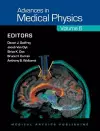
Advances in Medical Physics 2016
5 contributors - Paperback
£90.00
Jeffrey F. Williamson is a professor of Medical Physics at the Virginia Commonwealth University Massey Cancer Center. He received his Ph.D. in biophysical sciences in 1982 from the University of Minnesota in Minneapolis. Prior to joining VCU, he was a senior faculty member in the Department of Radiation Oncology at Washington University School of Medicine in St. Louis, Missouri, where he solidified his national reputation as an innovative researcher in brachytherapy. Dr. Williamson has several NIH-funded projects in the physics of this modality and is currently looking at novel methods for using imaging technology to improve the planning and delivery of brachytherapy to patients. One of his primary goals with this research is to extend the well-established role of Monte Carlo simulation as an accurate dosimetry tool to individual treatment planning. Dr. Williamson is also working in the area of deformable image registration. The goal of this research is to model distortion and movement of internal organs due to brachytherapy applicator insertion, tumor regression and changes in patient position. Shiva K. Das is Professor and Director of Physics and Computing Division at UNC School of Medicine. Previously he was a Professor in the Division of Medical Physics, Department of Radiation Oncology at Duke University, where he now holds an adjuct faculty position. He received his PhD in Engineering from Duke University and subsequently underwent post-doctoral training in Medical Physics at Duke. He joined the Radiation Oncology faculty in 1995. Dr. Das has received grants from the NIH, Whitaker Foundation, Coulter Foundation, Varian Medical Systems and the Duke Cancer Institute to study radiation-induced normal tissue injury modeling, knowledge-based radiotherapy planning, functional image-guided radiotherapy and the use of hyperthermia in cancer therapy. In addition to these areas of research, his other research areas include PET-based tumor segmentation, therapy response assessment using PET/MRI and small animal irradiation.